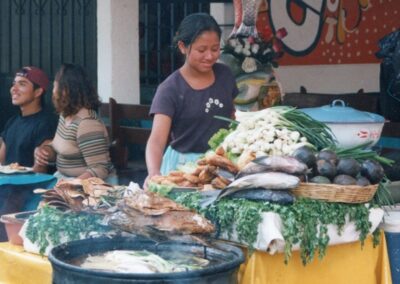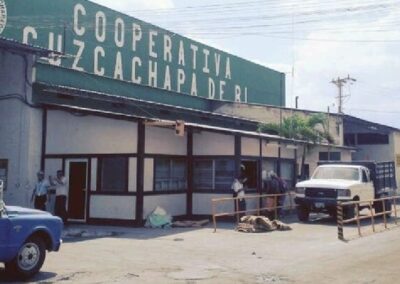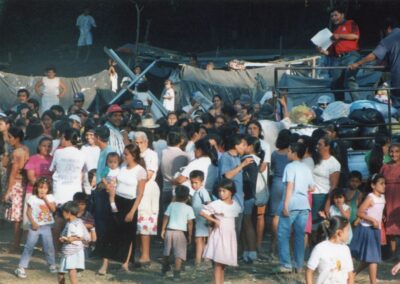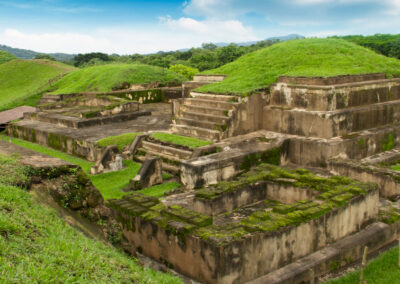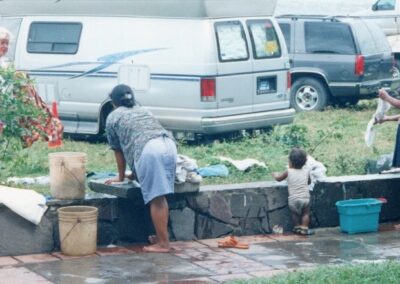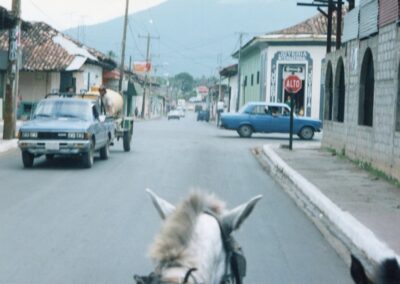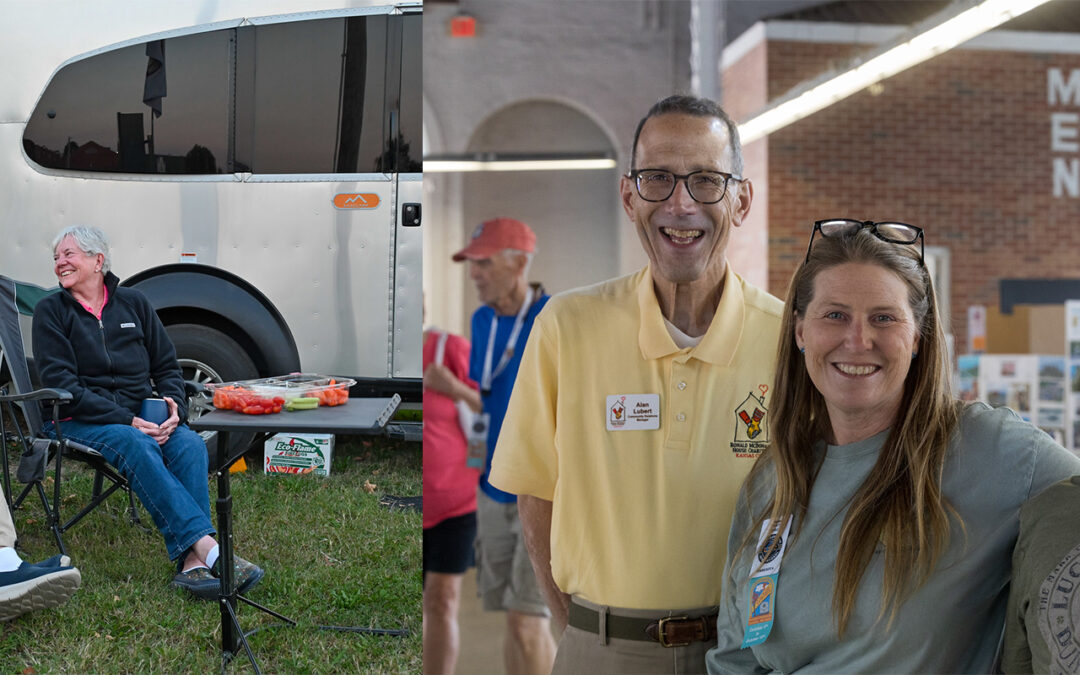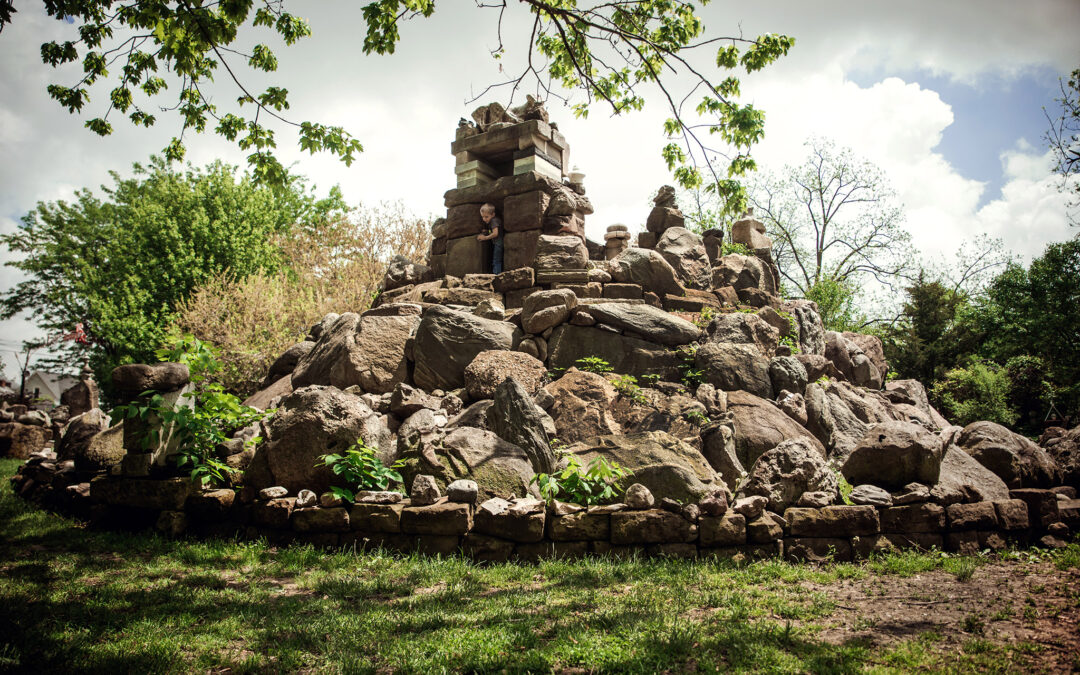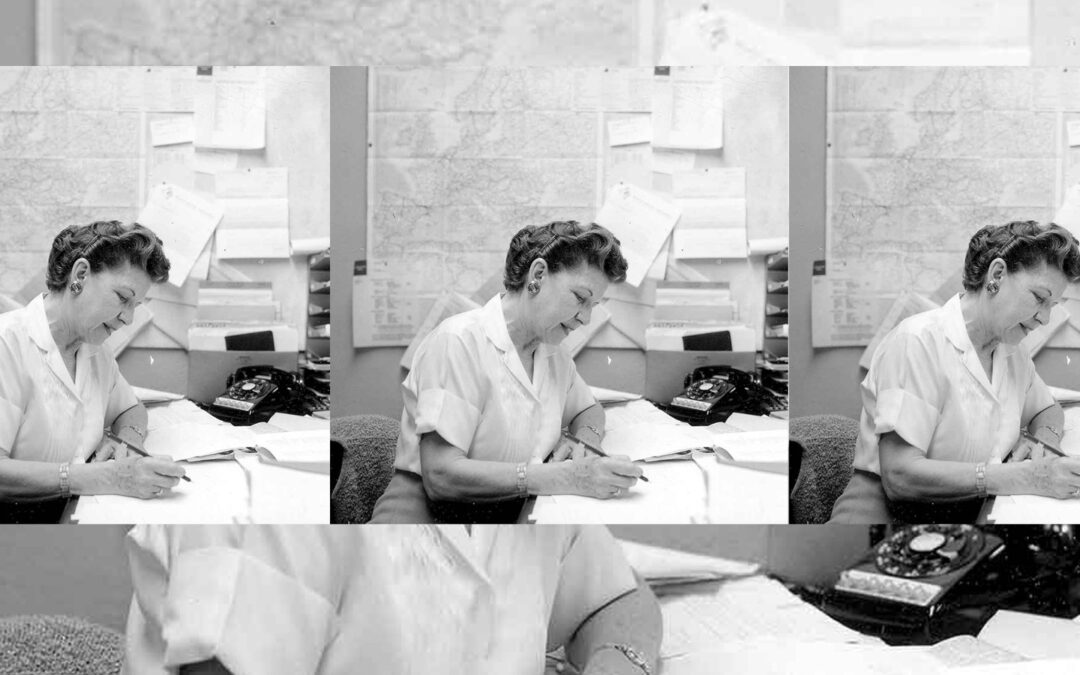This month, we continue the story penned by WBCCI member Linda Andrzejewski, BRN 16411, that she titled “The Trip of a Lifetime,” about her experiences on caravan 255A, the first of two 2001 50th Anniversary Caravans to Central America and Panama. We continue as caravan 255A leaves Mexico and heads further south into Central America:
GUATEMALA
Days 11 thru 16 (Jan. 22-27)
As we traveled along the outskirts of Guatemala, we saw evidence of their stronger economy than Mexico. First, the roads were in better condition and underwent regular maintenance. We watched as grass along the embankment was trimmed by hand using a machete, no powered weed-whackers here. Second, we traveled past fields of corn and stalk tobacco (this tobacco is used as filler for cigarettes and cigars). We also passed many American manufacturing plants such as Coke, Pepsi and Bayer to name a few.
During our stay in Guatemala, we had the opportunity to tour Antigua, originally the capital of the country. In 1773, an earthquake destroyed the city, and the capital was moved to its present location of Guatemala City. Antigua is a historical colonial city that dates back to 1543. Its setting is superb, high in the mountains amidst three magnificent volcanoes named Agua, Fuero and Acatenango. Fuero is easily recognized by its constant plume of smoke. On our next tour, we had the experience of riding on a famous “chicken bus” to Lake Amatitlan for a good view of the volcano named Pacaya. A chicken bus is a recycled yellow school bus from The States, brightly painted, decorated with religious pictures and crosses and named for a person’s loved one. The bus gets its name because it is highly likely to share your seat with a chicken.
On another day, we went to market day in the town of Chichicastenango. This town of 8,000 Mayan Indians has narrow cobblestone streets lined with vendor stalls of all kinds of ware and local crafts, the most famous being beautiful hand-woven cloths and embroidered fabrics.
EL SALVADOR
Days 16 thru 25 (Jan. 27-Feb. 5)
By the time we reached El Salvador, many of us experienced problems with our rigs. Two refrigerators had stopped functioning, thus we were freezing ice cubes so they could be used as “iced boxes,” remember those? Several people had experienced flat tires and others needed brake repairs on their trailers. Also, two tow vehicles developed electrical problems and had no lights. Inside the rigs, rivets came loose, drawers and cabinets wouldn’t stay closed, and two shower doors fell off. Remember when I previously mentioned how narrow and congested the borders are? Well, while crossing the International Bridge to El Salvador, one of the rigs “clipped” a tractor-trailer truck on the right side of their rig and broke the center and left support on their large awning. This damage occurred as one trailer truck was parked on the bridge while another was crossing the bridge, allowing little room for maneuvering. We were all thankful these were minor problems and nothing too serious. In comparison to El Salvador’s current situation, our problems seemed small and unimportant.
El Salvador is the smallest country in Central America with a total area the size of Massachusetts. This country has been and continues to be devastated by natural disasters. Erupting volcanoes, fierce hurricanes and frequent earthquakes disrupt daily life and the economy of this tiny country. Our tour of San Salvador was canceled due to extensive damage the city incurred from the quake. As we drove through the outskirts of the city, rockslides came into the roadways and swallowed whatever was in its path. Many roads appeared to have just opened up. Stone churches and other buildings in the town of Santa Anna were half standing. Mudslides caused serious damage and even death in mountainous areas. It was here that a dozen of the women on our trip rode in the back of an El Salvadorian Army truck to deliver clothes we brought to distribute to those in need. The people we met were very happy and appreciative of the items they received. I should note here that several of us experienced numerous aftershocks while others slept right through them and didn’t learn about the shocks until the next day.
On our return trip back thru El Salvador, we returned to San Vincente, a town where we had enjoyed their hospitality earlier, but which now was 75% destroyed by the second large earthquake in less than a month. Many of us viewed the devastation first-hand and came away with a better understanding of the serious consequences of “Mother Nature’s power.” We as a group purchased metal sheeting to be used by 30 families for protection from the coming rainy season.
Due to the fragile economic state of El Salvador and its people, to protect what little possessions they have, military presence was everywhere. Wherever there is money or status, banks, private clubs, offices, embassies, grocery stores, gas stations, even McDonald’s, there are armed guards. In most of the Central American countries and Mexico, this is the case with the exception being Panama. El Salvador is a poor country where the people continue to survive life’s many hardships. Recovery from natural disasters is slow, and hard work. It continues year after year.
Our Remaining Caravan
255A/255B Participants
The following Caravan 255A and 255B participants are still WBCCI members in 2023
255A
Linda Andrzejewski, BRN 811 (then BRN 16411)
Thomas and Ethelwyne Golden, BRN 16921
Bernie and Ann Lackmann, BRN 5987
Darlene Leslie, BRN 29 (Leader)
Connie Reeves, BRN 2833
255B
Stephen and Priscilla Harriman, BRN 6924
Lin and Maryke Hines, BRN 2567
Bert and Dot Kalet, BRN 6957
James Matkovich, BRN 1790
Bob and Susan Vandenheuvel, BRN 4621
HONDURAS
Day 25 (Feb. 5)
When we left El Salvador and entered Honduras, evidence of the natural disasters was still visible, however our spirits lifted as we drove through 55 miles of the countryside’s spectacular scenery. The Pan-American Highway took us up and over mountains where the roads had lots of sinkholes, landslides and road erosion with repairs from Hurricane Mitch still going on. The homes were larger than we had seen thus far and had a Spanish look. The yards were also very neat. Children came running to the edge of the road, waving as we passed by, fascinated by the silver “house on wheels.” When we crossed into Honduras the outside temperature was 90 degrees, but by the time we reached an elevation of 3,400 feet, it cooled down to a comfortable 75 degrees. Honduras is the second largest of the Central American countries with as much as 80% of total land area composed of rugged mountains. Lowlands are found only along both coasts and in several river valleys.
NICARAGUA
Days 25 thru 32 (Feb. 5-12)
When we arrived at the Nicaraguan border, the Secretary of Transportation and Tourism greeted us. He really made us feel welcomed and stressed that his country is very safe and opens its arms cheerfully to visitors. As we traveled the countryside, Hurricane Mitch devastation was still prominent. The roads that were not torn up still had washouts and potholes that could swallow the trailer. Landslides had left huge rocks in the roadway. Several of us, conversing over the CB, said we now understood what Wally Byam had experienced on his many trips thru Central America.
As we traveled along to Managua, we saw that the locals sell whatever is available to them, from rocks for building to live animals such as monkeys, colorful macaw birds, iguanas, armadillos and even alligators. These items were not exactly what we had in mind for souvenirs.
We spent three days in Granada, Nicaragua’s oldest Spanish city. It was founded in 1524 and sits at the foot of Volcano Mombacho on the northwestern shore of Lake Nicaragua. There are many coffee plantations on the slopes of this volcano. Lake Nicaragua is the 10th largest freshwater lake in the world. Forty-five rivers flow into it. The world’s only freshwater sharks live in the lake. The lake is home to many other unusual fish, including freshwater swordfish, sawfish, and tarpon. It is believed that both Lake Nicaragua and Lake Managua were originally part of a large Pacific Bay that was cut off from the ocean by the uplifting of the earth’s crust. Isolated from sea, the marine creatures adapted as the salt water gradually became fresh water.
A highlight of this country was the Volcan Masaya National Park with its principal crater, Volcan Santiago, a 635-meter-high volcano that is still very active. Incredibly, it is even possible to drive to the edge of the volcano. The flanks of the crater feature several smoking vents and places where there are thermal waters and hot earth. Luckily, the winds were blowing away from us so the sulfuric vapors, which are very strong, were going in the opposite direction. The vapors often prohibited people from standing so close to the edge of the crater. It really was quite a sight to see firsthand.
From the National Park, we visited the marketplace at Masaya , a town known as the “heart of Nicaraguan handicrafts and folklore.” Among the many items for sale are beautiful colorful cotton hammocks, hand-turned pottery, leatherworks, woodcarvings, marimbas (musical instruments made of wood), and colorful baskets.
To be continued.
Japanese Film Crew and Video
Caravan 255A was filmed from their rendezvous in McAllen, Texas all the way to Panama City, Panama, for a Japanese TV documentary for the Japan Broadcasting Corporation NHK (Nippon Hōsō Kyōkai) that was to air in Japan in May 2001. The title of the documentary roughly translates to “40 Days of Retirement in Central America in Travel Trailers.”
The four members of the Japanese film and sound crew (and one of their wives) traveled together in a Tioga Class C motorhome. The crew was always filming, and the caravan participants learned to expect to be filmed whenever they stepped out the door of their Airstream. On at least two occasions a helicopter was rented to do aerial filming.
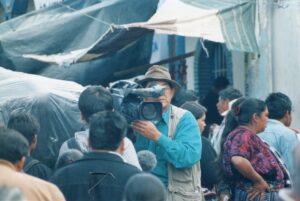
Filming in a city market
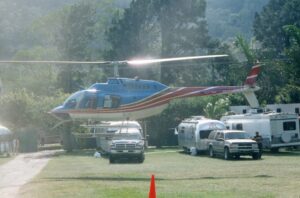
Helicopter in Amatitlan, Guatemala
The documentary was recently digitized by WBCCI member Damon Beals and is posted on the WBCCI YouTube page. The audio is in Japanese, but it has English subtitles.
Watch the full documentary below:


